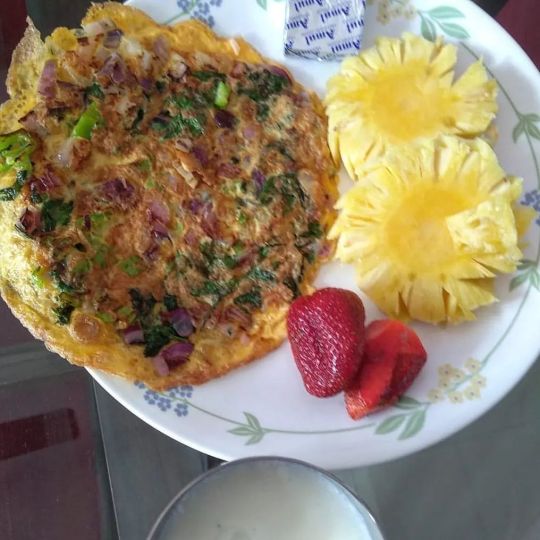#foodasmedicine
Text
🌿 Did you know that asparagus is not only delicious, but also great for hormonal health? 🌱
🌿 Asparagus is packed with nutrients that can help balance hormones, including folate, vitamin E, inulin, glutathione, and saponins. 🙌
👉 Folate helps with hormone synthesis
👉 Vitamin E regulates estrogen levels
👉 Inulin promotes healthy gut bacteria
👉Glutathione protects cells from oxidative damage, &
👉Saponins have anti-inflammatory and antioxidant properties. 🌟
🍴 Add asparagus to your meals to support your hormonal health!
👩🍳 Try this delicious recipe to your meals and let thy food be thy medicine!
#manjiriayurveda#foodasmedicine#ayurvedarecipe#ayurvedafood#vediccooking#healingfoods#asparagus#hormonalhealth#healthylifestyle#eatyourveggies#healthyeating#nutrition#healthyhabits#eatwelllivewell#vegetables#fiber#antioxidants#hormones#glutathione#ayurveda canada#gut health#holistichealth#holistic food#holistic healing#ayurveda#digestion#healthy lifestyle#ayurvedacanada#ayurveda near me
7 notes
·
View notes
Photo

"When we follow our traditional diets, we’re healthier people. Our immune systems can stand up to the seasons. One hundred years ago, diabetes and heart disease were nonexistent in our communities . . . Preventable diseases rise when we don’t have access to traditional foods” (as quoted in Hoover, 2019, p. 64). Somehow I don't think this only applies to indigenous peoples... Excerpt and figures from "Kincentricity and Indigenous Wellbeing Food(ways) and/as Holistic Health in the Native Medicine Wheel," by Rachel Presley as published in Rhetoric of Health and Medicine, Vol. 4, No. 2, pp. 126–157, DOI: 10.5744/rhm.2021.2002. #health #food #foods #diet #traditional #traditionalfood #kincentric #wholefood #seasonal #seasonalfood #foodsystems #foodsupply #medicine #medicinewheel #foodasmedicine #colonial #colonialism #decolonize #decolonizeyourmind #decolonizeyourdiet #beinghuman #humanfood #foodforhumans https://www.instagram.com/p/CqZEAwjPSsx/?igshid=NGJjMDIxMWI=
#health#food#foods#diet#traditional#traditionalfood#kincentric#wholefood#seasonal#seasonalfood#foodsystems#foodsupply#medicine#medicinewheel#foodasmedicine#colonial#colonialism#decolonize#decolonizeyourmind#decolonizeyourdiet#beinghuman#humanfood#foodforhumans
7 notes
·
View notes
Text
The Power of Nutrition: How to Eat Your Way to a Healthier Life

When it comes to achieving optimal health and well-being, there's no denying the important role that nutrition plays. The foods we eat provide our bodies with the energy and nutrients needed to function properly, and can have a profound impact on our physical and mental health. In this post, we'll explore the benefits of nutrition and healthy eating, and provide practical tips for incorporating more nourishing foods into your diet.
Benefits of Nutrition and Healthy Eating
Eating a well-balanced diet that is rich in whole, nutrient-dense foods has numerous benefits for your health. Here are just a few:
Reduced risk of chronic disease: A diet that is high in fruits, vegetables, whole grains, and lean protein sources has been linked to a lower risk of chronic diseases such as heart disease, diabetes, and cancer.
Improved mood and mental health: Certain foods, such as those rich in omega-3 fatty acids, can have a positive impact on mood and mental health, and may reduce the risk of depression and anxiety.
Increased energy and productivity: The right mix of carbohydrates, protein, and healthy fats can provide your body with sustained energy throughout the day, helping you feel more alert and productive.
Better digestion and gut health: Eating a diet that is high in fiber and fermented foods can support healthy digestion and promote a healthy gut microbiome.
Tips for Incorporating More Nutritious Foods into Your Diet
Here are some practical tips for incorporating more nutritious foods into your diet:
Focus on whole, nutrient-dense foods: Aim to include a variety of whole, nutrient-dense foods in your meals, such as fruits, vegetables, whole grains, lean proteins, and healthy fats.
Reduce processed and packaged foods: Many processed and packaged foods are high in added sugars, unhealthy fats, and sodium, and offer little in the way of nutritional value. Limit your consumption of these foods as much as possible.
Experiment with new recipes and flavors: Eating healthy doesn't have to be boring or bland. Experiment with new recipes and flavors to keep things interesting and exciting.
Practice mindful eating: Pay attention to your hunger and fullness cues, and aim to eat slowly and mindfully. This can help you enjoy your food more, and may prevent overeating.
Stay hydrated: Drinking plenty of water and other hydrating beverages can help support digestion, boost energy levels, and promote healthy skin and hair.
Conclusion
Nutrition and healthy eating play a crucial role in maintaining optimal health and well-being. By focusing on whole, nutrient-dense foods, reducing processed and packaged foods, and practicing mindful eating, you can support your physical and mental health and enjoy all the benefits that come with a healthy diet. So, start incorporating more nourishing foods into your diet today, and reap the rewards of a healthier, happier life.
#nutrition#healthyeating#wellness#healthylifestyle#eatwell#balanced diet#healthyfood#balanceddiet#mindfuleating#wholefoods#plantbased#nutrientdense#healthyliving#fitfood#healthychoices#healthyeatinghabits#healthylife#foodasmedicine#cleaneating#healthandwellness#eattherainbow#eatmoreplants#foodisfuel#nourishyourbody#healthylivingtips
3 notes
·
View notes
Photo

Post strength training muscle building fuel!! #foodasmedicine #musclebuilding #healthylifestyle (at Noida नोएडा) https://www.instagram.com/p/CpCeLfjy2gT/?igshid=NGJjMDIxMWI=
2 notes
·
View notes
Photo

@visualoutrun #visualoutrun #healthyfood #healthylifestyle #food #foodasmedicine #foodporn #organic #fitness #mealprep #foodphotography #vegan #healthyeating #mealprep #cardio #health #homemade #nutrition #breakfast #paleo #foodart #keto #tofu #vegetarian #caffeine #plantbased #veggies #balanced https://www.instagram.com/p/CnsbxtAhm6N/?igshid=NGJjMDIxMWI=
#visualoutrun#healthyfood#healthylifestyle#food#foodasmedicine#foodporn#organic#fitness#mealprep#foodphotography#vegan#healthyeating#cardio#health#homemade#nutrition#breakfast#paleo#foodart#keto#tofu#vegetarian#caffeine#plantbased#veggies#balanced
2 notes
·
View notes
Text
Delicious “crab cake” recipe with lion’s mane mushrooms. Supporting local growers is an added bonus. Great alternative can be made vegan or vegetarian. Highly recommend!
2 notes
·
View notes
Text

Oregano Crackers. Oregano is rich in antioxidants, such as rosmarinic acid and thymol, which help neutralize free radicals in the body. Read food recipe
Please do like, share, and subscribe to the channel if you genuinely love the content which I can promise you will. It would truly mean a lot! Thanks for your support.
Follow me 👉 https://foodrecipesoffical.com/
foodrecipesoffical.blogspot.com
https://foodrecipesoffical.com/wp-admin/post.php?post=3684&action=edit
foodrecipesoffical.blogspot.com
#OreganoBenefits#HerbalHealth#Antioxidants#AntiInflammatory#NaturalRemedies#DigestiveHealth#ImmuneSupport#CancerPrevention#HeartHealth#RespiratoryWellness#NutritionalHerbs#HealthyEating#HolisticHealth#WellnessWednesday#HealthyLiving#HerbalMedicine#FoodAsMedicine#InflammationRelief#GutHealth#NaturalAntibiotics
0 notes
Text
#GarlicBenefits#HealthyLiving#NaturalRemedies#Nutrition#Wellness#HeartHealth#ImmuneSupport#CancerPrevention#AntiInflammatory#Antioxidants#BloodSugarControl#DigestiveHealth#HealthyEating#FoodAsMedicine#GarlicRecipes#HealthyRecipes#HealthyLifestyle#HealthAndWellness#Superfoods#HealthyChoices
0 notes
Text
It is morning for many of us. So, I wish you all a Superb Day! I was tired at the end of my day yesterday that I simply passed out once I got home. Yesterday at work we had a potluck from one of the Reps who every now and then brings food to all staff at our outpatient clinic. It is essentially FREE food. Sometimes, the food is a little better than other times.
You may wonder what I mean by food being better at times. Well, for me nutrition is one of the major building blocks of our health and by association our wealth. In my mind, we have Real Food, and on the other hand, Nonfoods. It is pretty common knowledge, I think, but may be I am wrong, that most people know Bad Food (aka nonfoods, processed foods and so forth) cause inflammation. Inflammation has been discovered to be a major variable underlying most physical and mental maladies.
I am not sure what happens in your offices. In my office, people just flock towards these processed products touted as Real Food. Over the years, my peps at my office no longer ask me whether I am coming along to eat lunch at the breakroom because some Rep, or the other brought food. Thankfully, I weaned myself off nonfoods a couple of years ago. Most recently I weaned myself off the last nonfood, yogurt. I'd talk about that some other day. May be!
So, that got me thinking about The Psychology of Free, and the pull towards free stuff even when these freebies have are a great potential risk to our wellbeing. I know there are different perspectives on this phenomenon. Like with everything else, every concept, situation, verbalization and so forth has multiple perspectives - as many as there are people.
I have my own unique perspective on The Psychology of Free.
Here is a link to my blog page: https://9e8q.com/the-psychology-of-free/ on The Psychology of Free and why we have the pull not pay.
I encourage you to read it and then,
I'd like to read from you about your perspective on The Psychology of Free.
I found this quote that somewhat summaries one perspective on Freebies. I like it. I am not sure who came up with this quote. If you are the one? I Acknowledge You.

#mental health#physical health#health and wellness#wellbeing#healthyfood#foodasmedicine#food for thought#wellness
0 notes
Text
Holistic Nutrition 101: A Guide to Wholesome Well-Being

Welcome to "Holistic Nutrition 101" – your gateway to a transformative approach to health and wellness. In a world bombarded by fast food options, quick-fix diets, and a plethora of nutrition myths, the essence of true health often gets lost in the noise. This guide is designed to steer you back to the basics of nutrition — a holistic approach that nourishes not just the body, but the mind and spirit as well. Here, you'll discover how integrating simple, natural foods and mindful eating habits can significantly uplift your overall health. We're not just talking about short-term benefits; we're delving into a way of life that can help you feel more energized, balanced, and in tune with your body's natural rhythms. So, whether you're looking to overhaul your diet, manage a health condition, or simply improve your general well-being, you're in the right place.
Understanding Holistic Nutrition
Holistic nutrition is more than a diet; it's a comprehensive approach to health that views the individual as a complete system — one where physical, mental, and emotional aspects are interconnected and equally important. This approach is grounded in the philosophy that food is not only fuel but medicine, and that what we eat directly affects not just our physical health but our mental clarity, emotional balance, and overall quality of life.
The core principle of holistic nutrition is simple yet profound: eat foods that are as close to their natural state as possible. This means embracing a diet rich in whole, unprocessed foods like fresh fruits and vegetables, whole grains, lean proteins, and healthy fats. It's about prioritizing quality over quantity, understanding the source of your food, and recognizing the impact of your dietary choices on the environment and your health.
In holistic nutrition, every meal is an opportunity to positively impact your well-being. It's not just about avoiding unhealthy foods; it's about actively choosing foods that promote vitality, prevent illness, and enhance your overall life force. This form of nutrition considers individual dietary needs and preferences, making it a highly personalized and flexible approach. Whether you're dealing with specific health issues, dietary restrictions, or lifestyle choices, holistic nutrition can be tailored to meet your unique needs, making it a sustainable and enjoyable path to better health.
Benefits of Holistic Nutrition
Prevention of Chronic Diseases: A diet rich in whole, unprocessed foods is key in preventing various chronic diseases. Holistic nutrition helps maintain a healthy weight, reduces the risk of diseases like diabetes, heart disease, and certain cancers, and supports overall bodily functions.
Improved Mental and Emotional Well-being: What we eat affects not just our bodies but also our minds. A holistic diet, rich in nutrients, can improve mental clarity, mood, and emotional stability.
Energy and Vitality: Holistic nutrition emphasizes foods that naturally boost energy levels and improve metabolism.
Supports Digestive Health: Whole foods, particularly those high in fiber, play a crucial role in digestive health.
Customized to Individual Needs: Recognizing that each individual is unique, holistic nutritionists tailor dietary plans to suit personal health needs, preferences, and lifestyles.
Next, we'll explore practical ways to implement holistic nutrition principles in daily life, making it easier for you to embark on this rewarding journey towards better health.
Implementing Holistic Nutrition in Daily Life
Prioritize Whole, Unprocessed Foods: Start by incorporating more whole foods into your diet.
Hydration is Key: Ensure you're drinking enough water throughout the day.
Mindful Eating: Pay attention to your body's hunger and fullness cues.
Cook at Home: Preparing your meals at home can be a great way to control the ingredients.
Educate Yourself: Understanding the nutritional value of different foods is crucial.
Listen to Your Body: Everyone’s nutritional needs are unique.
Seek Professional Guidance: If you're unsure where to start or have specific dietary needs, consider consulting a holistic nutritionist.
Stay Informed: Educate yourself about holistic nutrition to make informed choices.
Enjoy the Process: Embrace the journey of holistic nutrition and celebrate the positive changes.
The Misunderstanding of Holistic Nutrition
Myth: Holistic Nutrition is Just a Trend: Holistic nutrition is a long-standing approach to eating that focuses on natural, whole foods.
Myth: It's All or Nothing: Holistic nutrition is about making gradual, sustainable changes.
Myth: Holistic Nutrition is Unscientific: Holistic nutrition is grounded in scientific principles.
Limitation: Not a Substitute for Medical Treatment: Holistic nutrition should not be seen as a substitute for professional medical treatment.
Limitation: Accessibility and Cost: Holistic nutrition is adaptable and can be practiced even within these constraints.
Myth: One-Size-Fits-All Approach: Holistic nutrition is highly individualized.
Practical Tips for Embracing Holistic Nutrition
Transitioning to a holistic nutrition lifestyle can be smooth and enjoyable with the right strategies. Here are some practical tips to help you embrace this approach:
Start with Breakfast: Begin your day with a nutritious, whole-food-based meal. Consider options like oatmeal with fresh fruits and nuts, a smoothie packed with greens and seeds, or eggs with whole-grain toast and avocado.
Smart Snacking: Replace processed snacks with healthier alternatives. Try hummus with vegetable sticks, fruit with a handful of nuts, or a small serving of natural yogurt.
Herbs and Spices: Enhance your meals with herbs and spices instead of relying on salt or sugar for flavor. This not only improves taste but also adds nutritional value.
Mindful Grocery Shopping: Plan your grocery shopping list to include more whole foods. Avoid aisles with processed foods and spend more time in the fresh produce section.
Batch Cooking and Meal Prepping: Prepare meals in advance to save time and ensure you have healthy options readily available throughout the week.
Stay Informed About Food Labels: Learn to read and understand food labels to make better choices when shopping for packaged foods.
Hydrate Creatively: If you find plain water unappealing, try infusing it with fruits, cucumber, or herbs like mint for a refreshing twist.
Experiment with Plant-Based Meals: Even if you're not a vegetarian or vegan, incorporating plant-based meals into your diet can add variety and extra nutrients.
Take It Slow: Remember, transitioning to holistic nutrition is a journey. Don’t be hard on yourself for occasional indulgences. It's all about balance and making more healthy choices over time.
Community Support: Connect with others who are interested in holistic nutrition. Join online forums, attend workshops, or find local groups where you can share ideas and get support.
By incorporating these practical tips into your daily routine, you can gradually shift towards a more holistic approach to nutrition, leading to improved health and well-being.
Getting Started with Holistic Nutrition
Assess Your Current Diet: Take a close look at what you're currently eating.
Plan Your Meals: Planning is key in holistic nutrition.
Gradual Changes: Begin with small, manageable changes to your diet.
Stay Hydrated: Proper hydration is essential for digestion, nutrient absorption, and overall health.
Listen to Your Body: Pay attention to how different foods make you feel.
Seek Support: Consider consulting a holistic nutritionist for personalized advice.
Stay Informed: Read books, follow blogs, or join health and nutrition groups.
**Mindful Eating**: Practice mindfulness when eating and listen to your body's cues.
Enjoy the Process: Embrace the journey towards a balanced and healthy lifestyle.
Conclusion
As we wrap up our journey through "Holistic Nutrition 101," remember that the path to well-being is a personal one. Holistic nutrition offers a way to honor your body's needs while nurturing your mind and spirit. It's about making choices that resonate with your individual health goals and lifestyle. Embrace the changes, no matter how small, and trust in the process of nurturing yourself holistically.
We'd love to hear from you! Share your experiences, challenges, or tips in the comments below. Your insights could be incredibly helpful to others and might just be the encouragement someone needs to start their own journey. Let's support each other in our quest for better health and well-being.
Frequently Asked Questions (FAQs)
Q: What are the first steps to transitioning to holistic nutrition?
A: Begin by gradually incorporating more whole, unprocessed foods into your diet, staying hydrated, and being mindful of your body's responses to different foods.
Q: Can holistic nutrition help with specific health conditions?
A: While holistic nutrition can support overall well-being and may help manage certain conditions, it should not replace medical treatment. Always consult healthcare professionals for specific health issues.
Q: Is holistic nutrition expensive?
A: While some aspects, like organic foods, can be more costly, holistic nutrition focuses on whole foods, which can be budget friendly. Planning and smart shopping can help manage costs effectively.
Q: How does holistic nutrition differ from traditional diets?
A: Holistic nutrition considers the whole person - mind, body, and spirit - and emphasizes natural, unprocessed foods, unlike many traditional diets that focus primarily on weight loss or calorie control.
Q: Can I practice holistic nutrition if I have dietary restrictions or allergies?
A: Absolutely. Holistic nutrition is highly individualized and can be adapted to accommodate various dietary needs, including allergies and restrictions.
#HolisticNutrition#HealthyEating#WellnessJourney#WholeFoods#MindfulEating#NutritionTips#CleanEating#NaturalWellness#HolisticHealth#BalancedDiet#EatWellLiveWell#NutritionMatters#FoodAsMedicine#HealthAndWellness#SustainableEating#HolisticLiving#NourishYourBody#HealthyLifestyle#WellnessBlog#NutritionEducation
0 notes
Text
#antibioticresistance#guthealth#probiotics#prebiotics#gutmicrobiome#digestivehealth#ibs#constipation#diarrhea#healthygut#healthydigestion#immunesystem#naturalremedies#foodasmedicine#wellness#selfcare#guthealthmatters#probioticsandprebiotics#probioticsforhealth#probioticsforimmunity
0 notes
Text

Looking for a natural way to balance your hormones?
Fenugreek tea might be your answer!
Fenugreek tea is known to be beneficial in balancing various hormones in the body.
Here are four hormones that fenugreek tea can help balance:
1. Estrogen: Fenugreek contains phytoestrogens that mimic the effects of estrogen in the body, making it helpful in balancing estrogen levels. This can be especially beneficial for women going through menopause or with hormonal imbalances.
2. Insulin: Fenugreek contains soluble fiber that can slow down the absorption of carbohydrates in the body, which helps regulate blood sugar levels. This can be particularly useful for those with diabetes or insulin resistance.
3. Prolactin: Fenugreek has been shown to increase milk production in nursing mothers, which is due to its ability to stimulate the hormone prolactin. This hormone is responsible for milk production in the body.
4. Testosterone: Fenugreek contains compounds that may help boost testosterone levels in men, which can help with muscle growth and sexual function. It is also be helpful for women with low testosterone to boost testosterone to improve muscle mass and libido. Fenugreek seeds also contain a compound called 4-hydroxyisoleucine, which has been shown to inhibit the activity of 5-alpha reductase, an enzyme that is involved in the conversion of testosterone to DHT. By inhibiting the activity of 5-alpha reductase, fenugreek seeds may help to reduce the levels of DHT in the body, which in turn may help to prevent hair loss and promote hair growth.
Overall, fenugreek tea can be a natural and effective way to balance hormones in the body.
So why not give it a try and see how it can benefit you?
#manjiriayurveda#hormonalimbalance#lowtestosterone#menopause#ayurvedaremedies#ayurvedicfood#foodasmedicine#FenugreekTea#HormoneBalance#Estrogen#Insulin#Prolactin#Testosterone#NaturalRemedies#HealthyLiving#wellness#gut health#holistic food#holistichealth#holistic healing#ayurveda#ayurveda canada#digestion#healthy lifestyle#healthyfood#ayurveda near me
6 notes
·
View notes
Link
Robert Ferguson Diet Free for Life Author Creator and Coachhttp://tobtr.com/s/12293464
0 notes
Text
क्या आपने कभी यह सोचा है कि आप जो अपनी रसोईघर में छिड़कते हैं, वह नमक का है? डॉ. आनस फासिह आपको एक स्वस्थ जीवन के लिए सही नमक चुनने पर मौन दे रहे हैं। हिमालयन पिंक सॉल्ट: डॉ. फासिह इस प्राकृतिक नमक की सलाह देते हैं क्योंकि इसमें पोटैशियम और मैग्नीशियम सहित समृद्ध खनिज होते हैं। यह एक स्वादपूर्ण विकल्प है जो आपके व्यंजनों को ऊँचा कर सकता है और स्वास्थ्य लाभ भी प्रदान कर सकता है।* सी सॉल्ट: एक और शीर्ष पसंद! इसकी प्राकृतिक कटाई प्रक्रिया और न्यूनतम प्रसंस्करण के साथ, सी सॉल्ट महत्वपूर्ण खनिजों को बनाए रखता है। डॉ. फासिह सुझाव देते हैं कि इसे अपने रसोई सफर में शामिल करें एक स्वादपूर्ण और स्वास्थ्ययुक्त यात्रा के लिए।* माध्यमिकता मायने रखती है: नमक के चयन के बावजूद, माध्यमिकता का मायना है। डॉ. फासिह रुचि के बिना स्वाद को संतुलित करने की महत्वपूर्णता पर जोर देते हैं, नमक के सेवन के लिए सतर्क दृष्टिकोण को प्रोत्साहित करते हैं।* रसोईघर का मतलब सिर्फ स्वाद नहीं है; यह हमारे स्वास्थ्य का एक महत्वपूर्ण पहलु है। डॉ. आनस फासिह के सुझावों का पालन करें ताकि आपके व्यंजनों में स्वाद ही नहीं, बल्कि स्वास्थ्य भी हो! 🌿🥗 **#स्वास्थ्यसूचना #पोषणसुझाव #��सोईस्वास्थ्य #डॉआनसफासिह #स्वस्थजीवन #healthtips #NutritionAdvice #CookingWellness #DrAnasFasih #healthyliving #HealthyEating #NutritionTips #WellnessJourney #MindfulCooking #FoodAsMedicine #HolisticHealth #BalancedDiet #KitchenWellness #SaltAwareness #HealthAndFlavor #SavorTheMoment #ConsciousCooking #CulinaryHealth #FlavorfulLiving #SmartSaltChoices #GourmetWellness #DietaryChoices #HeartHealth #MindfulEating #CookingForHealth which salt is good for health which salt is best for high blood pressure which salt is best for health which salt is best which salt is good for thyroid patients which salt is good for weight loss which salt is good for health in tamil which salt is good for babies which salt is good for high blood pressure which salt is good for health in telugu which salt is better for health which salt is best fit tuber which salt is good for kidney patients which salt is used in aquarium
#NutritionAdvice#CookingWellness#DrAnasFasih#healthyliving#HealthyEating#NutritionTips#WellnessJourney#MindfulCooking#FoodAsMedicine#HolisticHealth#BalancedDiet#KitchenWellness#SaltAwareness#HealthAndFlavor#SavorTheMoment#ConsciousCooking#CulinaryHealth#FlavorfulLiving#SmartSaltChoices#GourmetWellness#DietaryChoices#HeartHealth#MindfulEating#CookingForHealth which salt is good for health which salt is best for high blood pressure which salt is best for health which salt is best
0 notes
Text
What are some ways to incorporate more vegetables into family meals?

Introduction to Incorporating More Vegetables into Family Meals
Vegetables are an essential part of a balanced diet, providing a wealth of vitamins, minerals, and dietary fiber. However, incorporating them into family meals can sometimes be a challenge. Whether it's due to picky eaters or a lack of time and ideas, many families struggle to include enough vegetables in their diet. This blog post will explore creative and delicious ways to incorporate more vegetables into your family meals.
Importance of vegetables in a balanced diet
Vegetables are a powerhouse of nutrients. They are low in calories and high in vitamins, minerals, and antioxidants. They can help reduce the risk of chronic diseases, improve digestion, and contribute to overall health and well-being. Nutritional Therapy often emphasizes the importance of including a variety of vegetables in your diet.
Challenges of incorporating vegetables into family meals
Despite their numerous health benefits, vegetables can be a tough sell, especially for children. They may resist trying new foods, dislike certain textures, or simply prefer other flavors. Additionally, preparing vegetables can be time-consuming, and many families struggle to find quick and easy ways to include them in meals.
Overview of creative ways to include more vegetables
Fortunately, there are many creative strategies for incorporating more vegetables into meals. From making veggie-based soups and sauces to experimenting with vegetable substitutes and additions, there are countless ways to boost your family's vegetable intake. Let's explore some of these methods in detail.

Photo by engin akyurt on Unsplash
Creative Ways to Cook with Vegetables
Making veggie-based soups
Soups are a great way to pack a lot of vegetables into a single dish. They're also versatile, allowing you to use whatever vegetables you have on hand.
Benefits of veggie-based soups
Veggie-based soups are not only nutritious but also filling. They can help you feel satisfied while consuming fewer calories, making them a great option for weight management. Plus, they're comforting and perfect for cold weather.
Recipe suggestions
Try a classic vegetable soup with carrots, celery, and tomatoes, or experiment with a creamy butternut squash soup. For a more substantial meal, add beans, lentils, or whole grains.
Experimenting with veggie noodles
Veggie noodles, made from vegetables like zucchini, carrots, and sweet potatoes, are a fun and healthy alternative to traditional pasta.
Types of vegetables to use
While zucchini is the most common choice for veggie noodles, other vegetables like carrots, sweet potatoes, and cucumbers can also be used. Each offers a unique flavor and nutritional profile.
How to prepare veggie noodles
Use a spiralizer to turn your chosen vegetable into noodles. Then, sauté them in a bit of olive oil until tender, or serve them raw for a crunchy alternative.
Adding veggies to sauces
Blending vegetables into sauces is a sneaky way to increase your family's vegetable intake without them even noticing.
Types of sauces to consider
Tomato-based sauces are an obvious choice, but don't limit yourself. Try blending cooked carrots into a cheese sauce for a nutrient boost, or add spinach to a pesto sauce for extra fiber and vitamins.
Tips for blending veggies into sauces
Choose vegetables that complement the flavor of the sauce. Cook them until soft, then blend until smooth. If your family is resistant to visible veggies, this method can be a game-changer.
Preparing savory oatmeal with vegetables
Savory oatmeal is a hearty and nutritious meal that can easily incorporate a variety of vegetables.
Benefits of savory oatmeal
Adding vegetables to oatmeal increases its nutritional value and makes it more filling. Plus, savory oatmeal is a versatile dish that can be customized to suit your family's tastes.
Recipe suggestions
Try sautéing onions, bell peppers, and spinach to add to your oatmeal. For a flavor boost, top with a poached egg and a sprinkle of cheese.

Photo by Clayton Robbins on Unsplash
Innovative Vegetable Recipes
Making a cauliflower pizza crust
A cauliflower pizza crust is a delicious and low-carb alternative to traditional pizza dough.
Steps to make cauliflower pizza crust
Start by ricing the cauliflower in a food processor, then cook it until soft. Squeeze out as much water as possible, then mix with egg and cheese to form a dough. Bake until golden, then add your favorite toppings.
Benefits of cauliflower pizza crust
Cauliflower crust is lower in calories and carbs than traditional pizza crust, making it a great option for those watching their weight or blood sugar levels. Plus, it's a fun way to sneak more vegetables into a family favorite.
Cooking a veggie omelet
A veggie omelet is a quick and easy way to start the day with a serving of vegetables.
Ingredients for a veggie omelet
Choose any vegetables you like, such as bell peppers, onions, tomatoes, spinach, or mushrooms. You'll also need eggs, cheese, and any seasonings you prefer.
Steps to cook a veggie omelet
Sauté your chosen vegetables until tender, then add beaten eggs and cook until set. Sprinkle with cheese, fold in half, and serve.
Grilling veggie kebabs
Veggie kebabs are a fun and flavorful way to enjoy a variety of vegetables.
Choosing vegetables for kebabs
Choose vegetables that can withstand the heat of the grill, such as bell peppers, onions, zucchini, and cherry tomatoes. For added flavor, marinate the vegetables before grilling.
Grilling tips for veggie kebabs
Thread the vegetables onto skewers, then grill until charred and tender. Serve with a side of rice or quinoa for a complete meal.

Photo by engin akyurt on Unsplash
Vegetable Substitutes and Additions
Swapping to a veggie burger
Veggie burgers are a great way to enjoy a burger while still getting a serving of vegetables.
Benefits of veggie burgers
Veggie burgers are typically lower in fat and calories than traditional meat burgers, and they're a great source of fiber. Plus, they're a versatile option that can be customized with your favorite toppings.
How to make a veggie burger
Combine cooked vegetables, beans, and grains in a food processor, then form into patties and cook. Serve on a bun with your favorite toppings.
Adding veggies to tuna salad
Tuna salad is a classic lunch option that can easily be upgraded with the addition of vegetables.
Recommended vegetables for tuna salad
Try adding diced celery, bell peppers, or carrots for a crunch, or mix in some chopped spinach or kale for a nutrient boost.
Recipe for a veggie-rich tuna salad
Mix canned tuna with mayonnaise, mustard, and your chosen vegetables. Serve on whole grain bread or over a bed of lettuce.
Making cauliflower rice
Cauliflower rice is a low-carb alternative to traditional rice that's easy to make and versatile.
Steps to make cauliflower rice
Simply pulse cauliflower florets in a food processor until they resemble rice, then sauté in a bit of olive oil until tender.
Benefits of cauliflower rice
Cauliflower rice is lower in calories and carbs than traditional rice, making it a great option for those watching their weight or blood sugar levels. Plus, it's a fun way to sneak more vegetables into your meals.

Photo by David Suarez on Unsplash
Encouraging Children to Eat More Vegetables
Setting a good example with vegetables
Children are more likely to eat vegetables if they see their parents enjoying them. Make a point of eating a variety of vegetables and expressing your enjoyment of them.
Using praise when your child tries vegetables
Positive reinforcement can be a powerful motivator. Praise your child when they try a new vegetable, and encourage them to keep trying new ones.
Getting your child involved in cooking with vegetables
Children are more likely to eat foods they've helped prepare. Involve your child in cooking and let them help wash, peel, or chop vegetables. You can also encourage them to grow their own vegetables with these Gardening Tips.
Offering vegetables as snacks
Vegetables make great snacks. Offer carrot sticks, cherry tomatoes, or cucumber slices with a tasty dip, or try roasting chickpeas or edamame for a crunchy snack.
Going for vegetable variety, taste, and fun
Offer a variety of vegetables and prepare them in different ways to keep things interesting. Make vegetables fun by cutting them into fun shapes or serving them in colorful dishes.
Incorporating vegetables into meals in other ways
There are many other ways to incorporate vegetables into meals. Try adding them to sandwiches, wraps, or pizzas, or use them in place of grains in dishes like cauliflower rice or zucchini noodles.
With these tips and ideas, you can easily incorporate more vegetables into your family's meals. Remember, the goal is not perfection, but progress. Even small increases in vegetable intake can have a big impact on health. So start experimenting and find what works best for your family.
For more ideas on incorporating vegetables into meals, check out these 17 ways to eat more veggies or these 70 ways to include more vegetables in your diet.
Remember, eating more vegetables is not just about health, but also about enjoying a variety of flavors and textures. So get creative, have fun, and enjoy the journey to a healthier lifestyle.
#BalancedDiet #NutritionTips #HealthyEating #GardeningTips #FoodAsMedicine
Frequently Asked Questions - Incorporating More Vegetables into Family Meals
Why is it important to incorporate more vegetables into family meals?Vegetables are packed with essential nutrients, vitamins, and minerals that are vital for maintaining good health. They provide dietary fiber, which aids digestion and helps prevent constipation. Additionally, vegetables are low in calories and high in water content, making them a great choice for weight management. By incorporating more vegetables into family meals, you can improve the overall nutritional value of the dishes, promote healthy eating habits, and reduce the risk of chronic diseases.
How can I make vegetables more appealing to my family?There are several ways to make vegetables more appealing to your family. One approach is to involve them in the cooking process. Let your children choose a vegetable they would like to try and allow them to help with the preparation. You can also experiment with different cooking methods, such as roasting, grilling, or stir-frying, to enhance the flavor and texture of vegetables. Another idea is to incorporate vegetables into familiar dishes, like adding grated zucchini to spaghetti sauce or blending spinach into smoothies. Lastly, try presenting vegetables in a visually appealing way, such as arranging them in colorful salads or creating fun shapes with vegetable cutters.
How can I sneak vegetables into meals without my family noticing?If your family is resistant to eating vegetables, you can try sneaking them into meals without them noticing. One method is to finely chop or puree vegetables and add them to sauces, soups, or casseroles. For example, you can blend cooked carrots into tomato sauce or mix pureed cauliflower into mashed potatoes. Another option is to grate vegetables like zucchini or carrots and add them to baked goods such as muffins or bread. Additionally, you can use vegetables as a base for dishes, like using cauliflower rice instead of regular rice or spiralizing zucchini as a substitute for pasta.
How can I encourage my children to eat more vegetables?Encouraging children to eat more vegetables can be challenging, but there are strategies you can try. Lead by example and let your children see you enjoying a variety of vegetables. Make mealtime fun by involving them in the selection and preparation of vegetables. You can also create a reward system, where they earn points or stickers for trying new vegetables or eating a certain amount. Another approach is to make vegetables more appealing by serving them with dips or dressings. Finally, be patient and persistent. It may take several attempts before your children develop a taste for certain vegetables, so continue offering them in different ways and flavors.
What are some quick and easy ways to incorporate vegetables into meals?There are many quick and easy ways to incorporate vegetables into meals. Add a handful of spinach or kale to your morning smoothie. Toss a variety of colorful vegetables into a stir-fry or pasta dish. Make a vegetable-packed omelet or frittata for a nutritious breakfast or dinner. Stuff bell peppers or zucchini with a mixture of vegetables and lean protein. Create a refreshing salad with mixed greens, cherry tomatoes, cucumbers, and other vegetables of your choice. Lastly, make vegetable-based soups or stews using ingredients like carrots, celery, onions, and beans.
How can I meal plan to include more vegetables?Meal planning is an effective way to ensure that you include more vegetables in your family meals. Start by setting aside some time each week to plan your meals. Consider incorporating a variety of vegetables into your plan, including different colors and types. Choose recipes that feature vegetables as the main ingredient or as a significant component. Make a shopping list based on your meal plan and buy fresh, frozen, or canned vegetables accordingly. Prepping vegetables in advance, such as washing, chopping, or blanching, can also save time during busy weekdays. Lastly, try to include at least one vegetable side dish or salad with each meal to increase vegetable intake.
What are some creative ways to serve vegetables to picky eaters?For picky eaters, it can be helpful to get creative with how you serve vegetables. Consider making vegetable kebabs by threading colorful vegetables onto skewers and grilling or baking them. Another idea is to make vegetable-based dips, like hummus or guacamole, and serve them with sliced vegetables or whole-grain crackers. You can also make vegetable-based pizzas using cauliflower crust or whole-wheat tortillas as the base. Additionally, try making vegetable chips by thinly slicing vegetables like sweet potatoes or zucchini and baking them until crispy. Finally, consider serving vegetables in a fun and interactive way, such as creating a build-your-own salad bar or a make-your-own vegetable wrap station.
How can I make vegetables the star of the meal?To make vegetables the star of the meal, focus on creating dishes where vegetables take center stage. For example, make a hearty vegetable stir-fry with a variety of colorful vegetables and tofu or lean protein. Create a vegetable curry using a mix of spices, coconut milk, and vegetables like cauliflower, peas, and bell peppers. Make a vegetable-based lasagna or casserole using layers of sliced zucchini or eggplant instead of pasta. Another idea is to make vegetable-based burgers or patties using ingredients like black beans, lentils, or mushrooms. Lastly, experiment with vegetable-based salads by combining different textures, flavors, and dressings.
Read the full article
0 notes
Photo

@visualoutrun #visualoutrun #healthyfood #healthylifestyle #food #foodasmedicine #foodporn #organic #fitness #mealprep #foodphotography #vegan #healthyeating #mealprep #cardio #health #homemade #nutrition #breakfast #paleo #foodart #keto #tofu #vegetarian #caffeine #plantbased #veggies #balanced https://www.instagram.com/p/Cmn7EZ_J1i7/?igshid=NGJjMDIxMWI=
#visualoutrun#healthyfood#healthylifestyle#food#foodasmedicine#foodporn#organic#fitness#mealprep#foodphotography#vegan#healthyeating#cardio#health#homemade#nutrition#breakfast#paleo#foodart#keto#tofu#vegetarian#caffeine#plantbased#veggies#balanced
2 notes
·
View notes